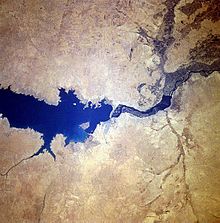
Back سد البعث Arabic سد البعث ARZ বাথ বাঁধ Bengali/Bangla Baath-Talsperre German Presa de Baath Spanish سد بعث Persian Barrage d’al-Baath French Bendungan Baath ID Diga al-Baʿth Italian 바스 댐 Korean
| Baath Dam | |
|---|---|
 Baath Dam (right), Tabqa Dam (centre), and Lake Assad (left) from space, June 1996. North is in the upper left corner of the image. | |
| Official name | سد البعث |
| Location | Raqqa Governorate, Syria |
| Coordinates | 35°53′07″N 38°44′50″E / 35.88528°N 38.74722°E |
| Construction began | 1983 |
| Opening date | 1986 |
| Dam and spillways | |
| Impounds | Euphrates |
| Height | 14 m (46 ft) |
| Reservoir | |
| Creates | Baath Dam Reservoir |
| Total capacity | 0.09 km3 (0.02 cu mi) |
| Power Station | |
| Installed capacity | 81 MW |
The Baath Dam (Arabic: سد البعث, lit. 'Dam of the Renaissance', Kurdish: Bendava Baas, Classical Syriac: ܣܟܪܐ ܕܒܥܬ, romanized: Sekro d'Ba'ath) is a dam on the Euphrates, located 22 kilometres (14 mi) upstream from the city of Raqqa in Raqqa Governorate, Syria. Construction of the dam started in 1983 and was finished in 1986. It is intended to generate hydroelectric power as well as regulate the irregular flow from the Tabqa Dam, which is located 18 kilometres (11 mi) upstream from the Baath Dam. These irregularities in the flow from the Tabqa Dam are caused by changes in the electricity demand.[1] The Baath Dam is 14 metres (46 ft) high and the installed water turbines can generate 81 MW. The storage capacity of the Baath Dam Reservoir is 0.09 cubic kilometres (0.022 cu mi).[2]
The Baath Dam is one of three dams on the Syrian Euphrates, the other two being the Tabqa Dam, and the Tishrin Dam 80 kilometres (50 mi) south of the Syria-Turkish border. Like the Baath Dam, the Tishrin Dam is also functionally related to the Tabqa Dam. Construction of the Tishrin Dam was partly motivated by the disappointing performance of the hydroelectric power station in the Tabqa Dam.[3] Before the Syrian Civil War, Syria had plans to construct a fourth dam – the Halabiye Dam – on the Euphrates, downstream from the Baath Dam.[4] The dam is named after the Syrian Arab Socialist Ba'ath Party.[5]
- ^ Shapland 1997, pp. 110–111
- ^ Kliot 1994, p. 138
- ^ Collelo 1987
- ^ Jamous 2009
- ^ "Syria revives important dam in Al-Raqqa". Al Masdar News. December 4, 2019. Archived from the original on May 11, 2020. Retrieved December 4, 2019.
